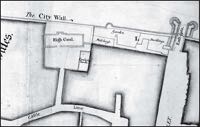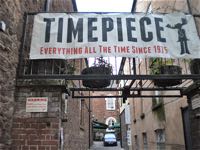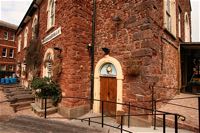
Castle Street Chapel
Originally the High Gaol, and now the Timepiece.
Researched and written by Julia Sharp
Page added 16th January 2015
See Timepiece
See Devon High Gaol
1662 is a milestone in the history of religious dissent in England with the passing of the Act of Uniformity. A number of the Clergy refused to consent and lost their benefices. From this group grew up the non-conformist movement in its many forms. In Exeter many of the leading citizens were non-conformist, the largest group being Presbyterians. Early in the 18th century Rev. James Pierce introduced ‘new notions’, which did not go down too well with many of the members. He resigned taking some members, who built for him a new Meeting House in Mint Lane. This opened in 1720 and followed the Arian principles. It closed later in the century when the remaining congregation moved to George’s Meeting House. The land was purchased in 1812 by other Protestant dissenters who, in 1813 opened the Mint Meeting House which still remains on the same site today.
By the end of the 18th century the Presbyterians had two places of worship; Bow meeting and George’s meeting. There were two Pastors, alternately officiating at each place; one Arian and the other Trinitarian. In 1794 Mr. Tozer the last Trinitarian Pastor died leaving the Arians to succeed him. Those dissatisfied with this had a hard choice, not being many or wealthy. However they decided to form a Congregational Church, build a Chapel, and support a Minister.
It so happened the Old County Prison or High Gaol, a place where so many non-conformists had been confined, was being demolished and the site for sale. They purchased the site, which was adjacent to the City Wall near the East Gate, and erected a new building known as Castle Street Chapel, using in part materials from the Old Gaol. This Chapel opened for public worship in 1797. The site included a narrow strip of land around the Chapel and between that and the City wall, which was used on occasions for burials. These continued on and off until the passing of the Burials Act in 1854. This regulated Burials mainly affecting dissenters, who had difficulty in being buried in Church graveyards. The Dissenters Burial Ground in Exeter was closed at the same time. A number of the Gravestones can still be seen decorating the outside walls of Timepiece nightclub which now occupies the site. A few years ago an archaeological excavation was carried out when a number of graves were found.
This was the time when many non-conformist Chapels were being built. As well as ministering to the congregation, the Leaders looked elsewhere to see how they could increase their influence. At about this time Sunday Schools ‘silently and secretly’ came into existence first appearing in Gloucester. Castle Street Chapel decided to establish such a School. Therefore the General Committee of the Chapel held a meeting on 25th May 1800 and resolved:-
1. That the congregation viewing with sorrow the ignorance and depravity of the youth—consider the establishment of a School—instructing on the Lords Day.
2. Committee of 15 be formed to Manage, with 3 to attend every Sabbath to teach.
3 That children attend 9-10.30am: 1.30 to nearly 2.30: and 5.0 to 6.0 evening
4. That the Minister meet them morning and afternoon to instruct them
5. Children to regularly attend morning & afternoon as parents prefer
6. That expenses incurred for rent of premises, books etc. be paid for by voluntary contributions and once a year a Sermon be preached and a public collection made on behalf of the Institution.
7. Committee subject to control of Congregation.
Initially rooms were hired to house the pupils, and these are thought to have been in a house nearby, and a School Mistress and School Master were employed. It is probable that the Teacher’s chief occupation was to teach the pupils to read. Quite soon the paid teachers were dismissed and the work carried out by volunteers. The rooms were also given up and the children taught in the gallery of the Chapel. As well, small branch schools were set up at various times, in such places as Countess Weir, Whipton, Exwick, and Lions Holt. Some of these were more successful than others.
After a few years, it was decided that having both the Congregation and Sunday School use the Chapel at the same time was inconvenient. Therefore in 1821 the Congregational Committee Resolved ‘That subscriptions be immediately entered into with a view of paying off the debt on the premises adjoining and also of building School Rooms thereon’ by December of that year they had decided not to erect a new School Room but to adopt means to liquidate the debt. All these plans were put to one side when Rev. J. Griffin died.
Rev. J. Bristow restored peace and prosperity, and about the mid 1830s arranged for a portion of the land known as the ‘barracks’ to be sold so that a new Schoolroom could be built, initially a single storey with a moveable partition to divide between boys and girls. £800 was paid in 1840 for work on the building possibly reorientation of the interior from facing southwest to northwest on its long axis as part of this development.
Next in 1852 an additional storey was built, because the increase in the Girls attendance meant the rooms were overcrowded, and stifling especially in the Summer months. It was thought most unreasonable to expect teachers to give their time and energy, have their comfort destroyed, and health imperilled in this way.
In the 1860s the Congregation decided it needed more room. To be precise, a larger Church in a better position, therefore in 1870 they moved to the new Congregational Church they had built in Southernhay.
As the Chapel was no longer needed for the Congregation it was decided to convert the old building into another School Room. When given the brief, it was noted that ‘the Architect was able to ensure ample school and class rooms were provided’. In 1875 the last addition to the School was built, a Lecture Hall on land adjoining the old Church. By this time, there were 579 boys, girls and infants on the Roll.
The World Wars
The Sunday School remained in the same buildings until 1939, apart from use during the First World War as part of Exeter War Hospital No. V. When a request was received early in 1915 for another War Hospital the buildings chosen were the College Hostel for Women (Bradninch) and Congregational Church School next the Castle. There was work needed to make them fit for use but by May 1915 there were 200 beds in Hospital V; 177 of which were in 7 wards.
The end came for the Sunday School in September 1939 when the building was surrendered to The War Office for use as recruiting offices. After the Second World War it was used by various government departments until it was passed to the Royal British Legion as Headquarters and Club in 1955. Work was carried out in 1976 to improve the building including the addition of a third storey billiard room.
The Timepiece
The Legion continued to use the buildings until the Timepiece Nightclub, then operating in the smaller Sunday School Building of 1833 to the southwest; exchanged premises with them in 1997. In 2016 the Timepiece Nightclub is still operating with a Beer Garden in which are standing around the walls, and against, in some parts, the City Wall, a number of gravestones.
Sources: Items found on the web; extracts from Rev. D. Hewitt booklet from Heavitree UR Church; report of Exeter Archaeology on Timepiece Nightclub; Report on WW1 War Hospitals in British Medical Journal
│ Top of Page │



